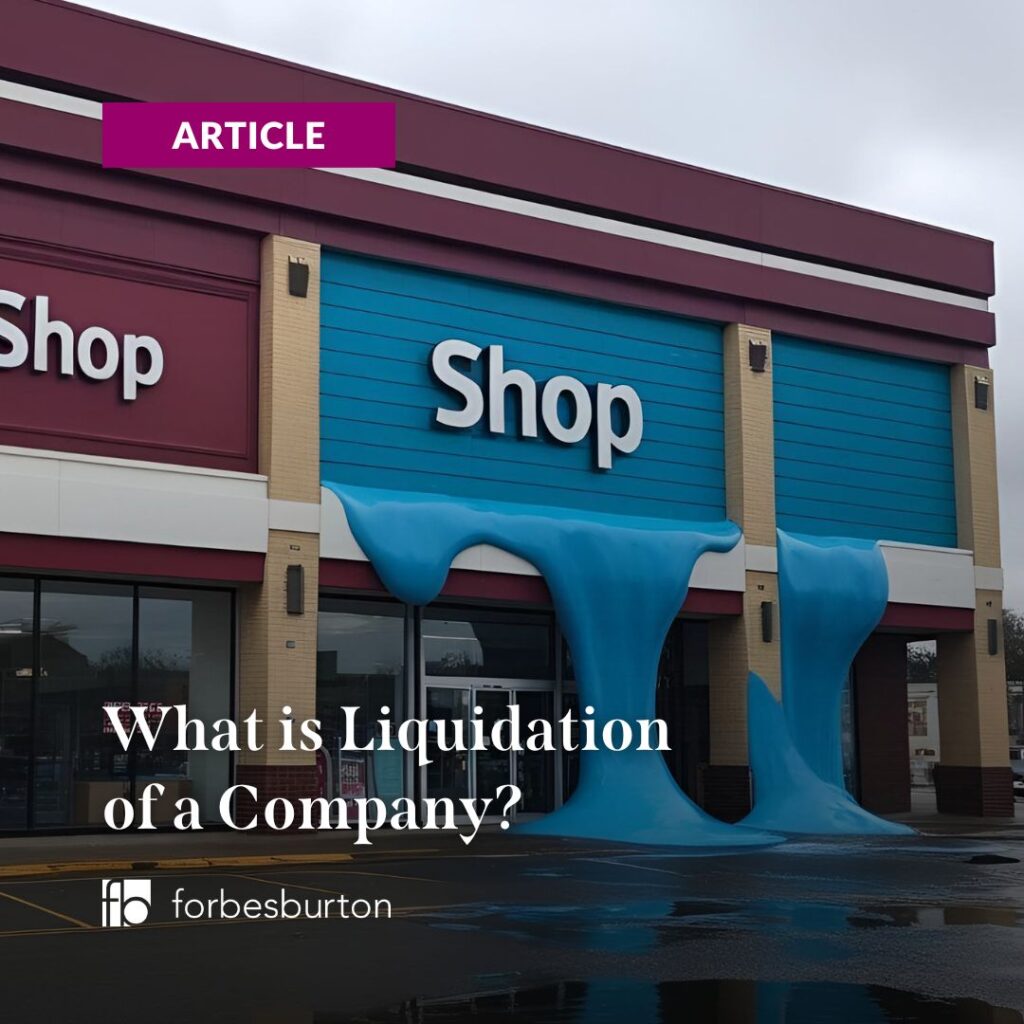
We get asked a lot of questions about company liquidation. Clients are often unsure what liquidation of a company is exactly, and whether it can be beneficial to their business.
As such, we’ve put together a quick guide that explains exactly what company liquidation is, the effect it can have on your business and the steps you need to take to make it happen.
What is meant by liquidation of a company?
Liquidation is part of a business closure in which a company’s assets are sold (or liquidated) in order to pay off creditors.
It is the process taken when closing a limited company, selling assets and dissolving the company from the official register.
This process tends to happen if you have cash flow problems on a regular basis and creditors are threatening to take enforcement action.
There are two types of liquidation that can be started by the directors of a company and it will depend on the situation of your company as to which is the right one to use:
Creditors’ voluntary liquidation (CVL): Used when a company is insolvent (which means it cannot pay its debts as and when they fall due. This is also used if you have assets that can be sold to generate cash or owe people money)
Members’ voluntary liquidation (MVL): Used when your company is solvent but you want to retire or you no longer need or want the company.
There is a third type of liquidation called compulsory liquidation, this is one that is forced upon the company by unhappy creditors and has to be processed through a court.
Is liquidation good for a company?
Whether liquidation is good or bad will depend on the circumstances of the company and the owner’s wishes.
While closing a business down can be upsetting for some, there are also some advantages to liquidating your company. Chief among those is the fact that you don’t have to leave the world of business altogether.
Instead, you can have a clean slate and start fresh.
- Eradicates the debt
The liquidation will write off the company debts once the assets have been sold off and whatever monies are raised are used to clear as much of the company’s outstanding debt as possible.
In most cases, some creditors will have to accept a loss; they won’t be happy, but it will be a weight off your mind.
- Eases the pressure
Although the liquidation process is difficult, you will not be undertaking it – the liquidators will, so this gives you time to breathe and take stock.
If you want to start a new business, you can get on with it and get back to asking investors to work towards a new successful business rather than paying off debt.
- Employees get paid redundancy
The cost of redundancies and restructuring do not apply as the company does not have the money to pay it. Another bonus is that the redundancies will be made by the liquidator, it may not eradicate bad feeling but it’s not your decision.
Employees will also be paid redundancy, even if there aren’t enough assets to cover the cost, this payment comes from the government. Directors of the company are also able to claim for redundancy pay; the average claim is currently around £9,000.
- It may not cost you anything
The initial cost of preparing the statement of affairs is usually relatively low and the remaining costs are taken from the sale of the company’s assets, so it won’t cost much for all the work to be done for you. And, as outlined above you may be able to claim for redundancy. If so, this can be used towards liquidation costs too.
What is the downside of liquidating a company?
It’s never fun to close down a company that you’ve worked so hard to build up. Alongside that, there are a handful of other potential drawbacks to some liquidations.
- Making staff redundant
When businesses are closed down, it’s sadly inevitable that any staff they had will be made redundant. This can be one of the most upsetting factors to liquidation for many directors.
- Personal guarantees will have to be paid
Usually, a limited company liquidation protects directors from any personal liability. However, if there has been any finance taken out using a personal guarantee, this will need to be repaid.
- Public procedure
Liquidations are announced in The Gazette, a free-to-access website alongside other closure details.
Case study:
After 40+ years of trading, the director of a freight-forwarding service sadly passed away. Inheriting the company was our client, his daughter, but what she found was a business struggling to pay its bills and irate suppliers cancelling contracts.
Without any scope for recovery, we recommended that the company was liquidated. By taking the reins of the business, we were able to remove all of the stress of angry creditors and the closure process for our client at a time of high emotion.
Case handler for this, Emma Blyth explained that “the client was keen to see that the remaining staff were given the redundancy payments they were due, and the company’s liquidation was able to provide this too.”
What happens when a company is in liquidation?
In general, a third party will oversee the sale of the company’s assets in order to raise enough money to pay its creditors. There are several stages that a liquidation will commonly go through.
1. Appointment of an insolvency practitioner
- Firstly, you’ll need to assess whether a liquidation is the right route for you and your company and choose who will carry it out
- An insolvency practitioner (IP) will then need to be informally appointed; this is the liquidator who will be in charge of the whole process
- They will gather the information that they need from the director, including company accounts, records, and also creditor, asset and cash flow information
- This information will be organised and official documents will be written up
- An assessment of the Statement of Affairs, the company’s financial position’ will usually be included here
- If the company is entering an member’s voluntary liquidation (MVL), a Declaration of Solvency will also need to be signed at this point
2. Gazette publication
- The proposed liquidation action must be advertised in the Gazette (which is now solely an on-line publication)
- This is mandatory for all companies that are proposing closure, in the interest of creditors; it enables them to submit their claims to the correct party
3. Meeting of creditors
- Next, any creditors who put forward a claim are corresponded with. They must be given a certain period of time to respond
- They will either be notified at least 7 days before the creditors meeting, or given notice that unless they object to the process it will be going ahead
- Please note; Until very recently, physical creditors meetings were required, but this process can now be done virtually; it is down to the liquidator which path they will take, but increasingly, virtual meetings will now become the norm
- Deemed Consent; It is now possible for liquidators to assume that creditors consent to the liquidation unless they have objected to the process. This is referred to as ‘deemed consent’.
- If creditors meetings are held (virtually or otherwise), the intended IP will lead the meeting, although the company Director is technically the chairman
- These meetings are usually completely stress-free; creditors will vote to confirm that Liquidating the company is it’s best option, and that the liquidator can be officially appointed to oversee the liquidation
4. Liquidation (of assets, if any)
- The term liquidation actually refers to the sale and disbursement of the company assets i.e. turning something physical into ‘liquid’ cash
- The firm’s assets will be sold by the liquidator at their highest possible value and the cash will be used to pay off any company liabilities
- Usually, items will be auctioned, but it is possible for Directors to buy the assets themselves. However, the price must match that of an independent valuation, and this must be deemed to be in the best interests of the creditors
- After all the assets have been sold, the cost of the Liquidation (the Insolvency Practitioners fees) will be paid, and creditor claims will be settled
- The IP will then formally dissolve the company so that it is removed from the companies house register. Once this has been done the process is completed
Of course, in cases where there are little or no company-owned assets, the liquidators must still be paid. In this case, there are two options:
- An instalment agreement would be drawn up to pay the liquidator
- The IP takes on instruction on the understanding that a proportion of the director’s redundancy claim would be used to fund the liquidation when the payment has come through

Is liquidation the same as closing?
Not necessarily. There are other types of company closure, such as dissolution, that don’t involve the liquidation of assets. In general, while a closure needn’t involve liquidation, liquidation always involves a closure.
Who benefits from liquidation?
A good liquidation can benefit both creditor and business owner. As there is an attempt to pay the company’s debts off, this benefits its creditors. Because it’s an effective way to solve business debts, it’s also beneficial to company owners.
Who gets paid first in liquidation?
- Secured creditors with fixed charges
- Preferential creditors (staff wages, etc.)
- Secondary preferential creditors (VAT, NI contributions, etc.)
- Secured creditors with floating charges
- Unsecured creditors
- Shareholders
What happens to a director of a company in liquidation?
As directors are subject to a thorough investigation into their conduct as part of a liquidation, the consequences of the process depend on the director’s conduct. In most cases, nothing happens to the director at all. If, however, any evidence of misconduct is found, a disqualification from acting as a director can be implemented.
In the vast majority of cases, the limited company liquidation process has no effect on company directors.
Of course, it will technically be public knowledge that you were once a director of a company that is now in liquidation, but this would only be seen if someone has done an in-depth search on you (and the outstanding debts are not public knowledge).
As far as your personal credit rating and reputation goes, there should be no lasting effect whatsoever.
There are, of course, exceptions. You may have heard the horror stories of personal liability and disqualification, but if any problems are going to arise, our job is to pin-point them beforehand, and we will advise you on the appropriate action.
How long does it take to liquidate a limited company?
There is no maximum time limit for a company to stay in liquidation. Typically, the process takes between 6-24 months to complete but can take longer should there be any disputes along the way.
Do contracts terminate on liquidation?
Any contracts will have already been terminated before a liquidation is completed. As part of the process, the business must cease trading immediately. Creditors are also involved in the process during meetings and are notified by the liquidator early on. Any staff, meanwhile, should have been let go once the business stopped trading.
Can a company be saved from liquidation?
There are many options available to companies worried that they might become insolvent. If they’ve already entered into liquidation, however, it is very difficult to reverse.
While technically possible to reverse a voluntary liquidation within 6 years of the formal dissolution, it’s very difficult and requires a court order and a great deal of legal work.
Understanding the different types of company liquidation
Solvent Liquidation
Solvent liquidation, also known as a members’ voluntary liquidation, is when the directors and shareholders have the choice to close their limited company down, with the intention of withdrawing cash or assets in a tax-efficient way. This process can take anywhere between six and 24 months, but this of course depends on the company’s current position.
Insolvent Liquidation
Insolvent liquidation or creditors’ voluntary liquidation, means that your company is having to close because it can’t pay its bills or debt anymore, or the value of the business assets is less than its liabilities. Similar to solvent liquidation, this process roughly takes between 6 – 24 months.
Compulsory Liquidation
Compulsory liquidation is a court-based process under which the assets of a company are released and distributed to the company’s creditors. This process is started by the filing of a petition at court. Once your company has gone into compulsory liquidation you will be banned for 5 years from forming, managing or promoting any business with the same or similar name to your previous company.
What are the consequences of liquidation?
Once your company has been liquidated it will be ‘struck off’ the listings of Companies House. All of your assets will then be used to pay off any outstanding debts, if you have any money left after this it will go to the company shareholders. After your business has gone into liquidation you cannot continue the company at a later date, unless a court order decrees it.
Think a liquidation might benefit your company?
UK businesses have had to contend with setback after setback over the last few years. Global pandemics, cost-of-living-crises, and energy price hikes have all contributed to making operating a business more difficult than it has been for some time.
If you’re concerned that your company will struggle to absorb these and other costs in the future, you need to seek help before it becomes an issue.
We have specialists on hand that can help you to facilitate turnaround strategies, sell your business, or close down your company depending on the best route available to you. Call us on 0800 975 0380, or email advice@forbesburton.com for a free consultation.
Alternatively, you can find out if your company qualifies for liquidation with our online liquidation test.
Author

Ben Westoby
ben.westoby@forbesburton.com
Related Articles
We're here for you.
As a dedicated team of Advisers and Consultants our aim is to help you fix the issues and solve the problems within your business.
Find out more →

